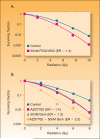Improving gemcitabine-mediated radiosensitization using molecularly targeted therapy: a review
- PMID: 18980967
- PMCID: PMC2697824
- DOI: 10.1158/1078-0432.CCR-08-1032
Improving gemcitabine-mediated radiosensitization using molecularly targeted therapy: a review
Abstract
In the last three decades, gemcitabine has progressed from the status of a laboratory cytotoxic drug to a standard clinical chemotherapeutic agent and a potent radiation sensitizer. In an effort to improve the efficacy of gemcitabine, additional chemotherapeutic agents have been combined with gemcitabine (both with and without radiation) but with toxicity proving to be a major limitation. Therefore, the integration of molecularly targeted agents, which potentially produce less toxicity than standard chemotherapy, with gemcitabine radiation is a promising strategy for improving chemoradiation. Two of the most promising targets, described in this review, for improving the efficacy of gemcitabine radiation are epidermal growth factor receptor and checkpoint kinase 1.
Figures




Similar articles
-
The combination of epidermal growth factor receptor inhibitors with gemcitabine and radiation in pancreatic cancer.Clin Cancer Res. 2008 Aug 15;14(16):5142-9. doi: 10.1158/1078-0432.CCR-07-4072. Clin Cancer Res. 2008. PMID: 18698032 Free PMC article.
-
[Gemcitabine: a new chemotherapy agent for solid cancers].Rev Med Brux. 1997 Oct;18(5):328-34. Rev Med Brux. 1997. PMID: 9441329 Review. French.
-
Randomized phase II--study evaluating EGFR targeting therapy with cetuximab in combination with radiotherapy and chemotherapy for patients with locally advanced pancreatic cancer--PARC: study protocol [ISRCTN56652283].BMC Cancer. 2005 Oct 11;5:131. doi: 10.1186/1471-2407-5-131. BMC Cancer. 2005. PMID: 16219105 Free PMC article. Clinical Trial.
-
Synergistic antitumor activity of ZD6474, an inhibitor of vascular endothelial growth factor receptor and epidermal growth factor receptor signaling, with gemcitabine and ionizing radiation against pancreatic cancer.Clin Cancer Res. 2006 Dec 1;12(23):7099-107. doi: 10.1158/1078-0432.CCR-06-0833. Clin Cancer Res. 2006. PMID: 17145834
-
Radiation sensitizers and targeted therapies.Oncology (Williston Park). 2003 Dec;17(12 Suppl 13):23-8. Oncology (Williston Park). 2003. PMID: 14723003 Review.
Cited by
-
Aberrant glycogen synthase kinase 3β in the development of pancreatic cancer.J Carcinog. 2012;11:15. doi: 10.4103/1477-3163.100866. Epub 2012 Sep 13. J Carcinog. 2012. PMID: 23230392 Free PMC article.
-
Inhibition of Neddylation Modification Sensitizes Pancreatic Cancer Cells to Gemcitabine.Neoplasia. 2017 Jun;19(6):509-518. doi: 10.1016/j.neo.2017.04.003. Epub 2017 May 20. Neoplasia. 2017. PMID: 28535453 Free PMC article.
-
Mechanisms for Tuning Engineered Nanomaterials to Enhance Radiation Therapy of Cancer.Adv Sci (Weinh). 2020 Oct 28;7(24):2003584. doi: 10.1002/advs.202003584. eCollection 2020 Dec. Adv Sci (Weinh). 2020. PMID: 33344143 Free PMC article. Review.
-
Aberrant glycogen synthase kinase 3β is involved in pancreatic cancer cell invasion and resistance to therapy.PLoS One. 2013;8(2):e55289. doi: 10.1371/journal.pone.0055289. Epub 2013 Feb 8. PLoS One. 2013. PMID: 23408967 Free PMC article.
-
Low-Dose Hsp90 Inhibitor Selectively Radiosensitizes HNSCC and Pancreatic Xenografts.Clin Cancer Res. 2020 Oct 1;26(19):5246-5257. doi: 10.1158/1078-0432.CCR-19-3102. Epub 2020 Jul 27. Clin Cancer Res. 2020. PMID: 32718999 Free PMC article.
References
-
- Safran H, Dipetrillo T, Iannitti D, et al. Gemcitabine, paclitaxel, and radiation for locally advanced pancreatic cancer: a Phase I trial. International journal of radiation oncology, biology, physics. 2002;54:137–41. - PubMed
-
- Blackstock AW, Melin SA, Butler JM, et al. Irinotecan/gemcitabine followed by twice-weekly gemcitabine/radiation in locally advanced pancreatic cancer. Oncology (Williston Park) 2002;16:25–8. - PubMed
-
- Kachnic LA, Shaw JE, Manning MA, Lauve AD, Neifeld JP. Gemcitabine following radiotherapy with concurrent 5-fluorouracil for nonmetastatic adenocarcinoma of the pancreas. International journal of cancer. 2001;96:132–9. - PubMed
-
- Symon Z, Davis M, McGinn CJ, Zalupski MM, Lawrence TS. Concurrent chemoradiotherapy with gemcitabine and cisplatin for pancreatic cancer: from the laboratory to the clinic. International journal of radiation oncology, biology, physics. 2002;53:140–5. - PubMed
Publication types
MeSH terms
Substances
Grants and funding
LinkOut - more resources
Full Text Sources
Other Literature Sources
Research Materials
Miscellaneous

